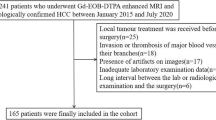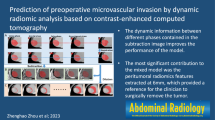Abstract
Objectives
Preoperative prediction of microvascular invasion (MVI) in patients with hepatocellular cancer (HCC) is important for surgery strategy making. We aimed to develop and validate a combined intratumoural and peritumoural radiomics model based on gadolinium-ethoxybenzyl-diethylenetriamine (Gd-EOB-DTPA)-enhanced magnetic resonance imaging (MRI) for preoperative prediction of MVI in primary HCC patients.
Methods
This study included a training cohort of 110 HCC patients and a validating cohort of 50 HCC patients. All the patients underwent preoperative Gd-EOB-DTPA-enhanced MRI examination and curative hepatectomy. The volumes of interest (VOIs) around the hepatic lesions including intratumoural and peritumoural regions were manually delineated in the hepatobiliary phase of MRI images, from which quantitative features were extracted and analysed. In the training cohort, machine-learning method was applied for dimensionality reduction and selection of the extracted features.
Results
The proportion of MVI-positive patients was 38.2% and 40.0% in the training and validation cohort, respectively. Supervised machine learning selected ten features to establish a predictive model for MVI. The area under the receiver operating characteristic curve (AUC), sensitivity, specificity of the combined intratumoural and peritumoural radiomics model in the training and validation cohort were 0.85 (95% confidence interval (CI), 0.77–0.93), 88.2%, 76.2%, and 0.83 (95% CI, 0.71–0.95), 90.0%, 75.0%, respectively.
Conclusions
We evaluate quantitative Gd-EOB-DTPA-enhanced MRI image features of both intratumoural and peritumoural regions and provide an effective radiomics-based model for the prediction of MVI in HCC patients, and may therefore help clinicians make precise decisions regarding treatment before the surgery.
Key Points
• An effective radiomics model for prediction of microvascular invasion in HCC patients is established.
• The radiomics model is superior to the radiologist in prediction of MVI.
• The radiomics model can help clinicians in pretreatment decision making.






Similar content being viewed by others
Abbreviations
- 3D VIBE:
-
Three-dimensional volume interpolated breath-hold test
- AFP:
-
Alpha-fetoprotein
- AIC:
-
Akaike information criterion
- ALT:
-
Alanine aminotransferase
- AST:
-
Aspartate aminotransferase
- AUC:
-
Area under receiver operating characteristic curve
- CI:
-
Confidence interval
- CT:
-
Computed tomography
- FLASH:
-
Fast low angle shot
- FS:
-
Fat suppression
- Gd-EOB-DTPA:
-
Gadolinium-ethoxybenzyl-diethylenetriamine
- GGT:
-
Gamma-glutamyltransferase
- HASTE:
-
Half-Fourier single-shot turbo spin-echo
- HBP:
-
Hepatobiliary phase
- HCC:
-
Hepatocellular cancer
- ICC:
-
Intra-class correlation coefficient
- KW:
-
Kruskal-Wallis
- LASSO:
-
Least absolute shrinkage and selection operator
- MRI:
-
Magnetic resonance imaging
- MVI:
-
Microvascular invasion
- NPV:
-
Negative predictive value
- PPV:
-
Positive predictive value
- Rad score:
-
Radiomics score
- RFS:
-
Recurrence-free survival
- ROI:
-
Region of interest
- TSE:
-
Turbo spin-echo
- VOI:
-
Volume of interest
References
Poon RT, Fan ST, Ng IO, Lo CM, Liu CL, Wong J (2000) Different risk factors and prognosis for early and late intrahepatic recurrence after resection of hepatocellular carcinoma. Cancer 89:500–507
Imamura H, Matsuyama Y, Tanaka E et al (2003) Risk factors contributing to early and late phase intrahepatic recurrence of hepatocellular carcinoma after hepatectomy. J Hepatol 38:200–207
Lim KC, Chow PK, Allen JC et al (2011) Microvascular invasion is a better predictor of tumour recurrence and overall survival following surgical resection for hepatocellular carcinoma compared to the Milan criteria. Ann Surg 254:108–113
Zhou YM, Yang JM, Li B et al (2010) Risk factors for early recurrence of small hepatocellular carcinoma after curative resection. Hepatobiliary Pancreat Dis Int 9:33–37
Roayaie S, Blume IN, Thung SN et al (2009) A system of classifying microvascular invasion to predict outcome after resection in patients with hepatocellular carcinoma. Gastroenterology 137:850–855
Mazzaferro V, Llovet JM, Miceli R et al (2009) Predicting survival after liver transplantation in patients with hepatocellular carcinoma beyond the Milan criteria: a retrospective, exploratory analysis. Lancet Oncol 10:35–43
Iwatsuki S, Dvorchik I, Marsh JW et al (2000) Liver transplantation for hepatocellular carcinoma: a proposal of a prognostic scoring system. J Am Coll Surg 191:389–394
Shi M, Guo RP, Lin XJ et al (2007) Partial hepatectomy with wide versus narrow resection margin for solitary hepatocellular carcinoma: a prospective randomized trial. Ann Surg 245:36–43
Sun JJ, Wang K, Zhang CZ et al (2016) Postoperative adjuvant transcatheter arterial chemoembolization after R0 hepatectomy improves outcomes of patients who have hepatocellular carcinoma with microvascular invasion. Ann Surg Oncol 23:1344–1351
Cucchetti A, Piscaglia F, Grigioni AD et al (2010) Preoperative prediction of hepatocellular carcinoma tumour grade and micro-vascular invasion by means of artificial neural network: a pilot study. J Hepatol 52:880–888
Lee S, Kim SH, Lee JE, Sinn DH, Park CK (2017) Preoperative gadoxetic acid-enhanced MRI for predicting microvascular invasion in patients with single hepatocellular carcinoma. J Hepatol 67:526–534
Banerjee S, Wang DS, Kim HJ et al (2015) A computed tomography radiogenomic biomarker predicts microvascular invasion and clinical outcomes in hepatocellular carcinoma. Hepatology 62:792–800
Huang M, Liao B, Xu et al (2018) Prediction of microvascular invasion in hepatocellular carcinoma: preoperative Gd-EOB-DTPA-dynamic enhanced MRI and histopathological correlation. Contrast Media Mol Imaging 2018:9674565
Kumar V, Gu Y, Basu S et al (2012) Radiomics: the process and the challenges. Magn Reson Imaging 30:1234–1248
Li Y, Liu X, Xu K et al (2018) MRI features can predict EGFR expression in lower grade gliomas: a voxel-based radiomic analysis. Eur Radiol 28:356–362
Esteva A, Kuprel B, Novoa RA et al (2017) Dermatologist-level classification of skin cancer with deep neural networks. Nature 542:115–118
Braman NM, Etesami M, Prasanna P et al (2017) Intratumoral and peritumoral radiomics for the pretreatment prediction of pathological complete response to neoadjuvant chemotherapy based on breast DCE-MRI. Breast Cancer Res 19:57
Yushkevich PA, Piven J, Hazlett HC et al (2006) User-guided 3D active contour segmentation of anatomical structures: significantly improved efficiency and reliability. Neuroimage 31:1116–1128
Leijenaar RT, Carvalho S, Velazquez ER et al (2013) Stability of FDG-PET radiomics features: an integrated analysis of test-retest and inter-observer variability. Acta Oncol 52:1391–1397
Le TN, Bao PT, Huynh HT (2016) Liver tumor segmentation from MR images using 3D fast marching algorithm and single hidden layer feedforward neural network. Biomed Res Int 2016:3219068
Clément O, Mühler A, Vexler V, Berthezène Y, Brasch RC (1992) Gadolinium-ethoxybenzyl-DTPA, a new liver-specific magnetic resonance contrast agent. Kinetic and enhancement patterns in normal and cholestatic rats. Invest Radiol 27:612–619
Hamm B, Staks T, Mühler A et al (1995) Phase I clinical evaluation of Gd-EOB-DTPA as a hepatobiliary MR contrast agent: safety, pharmacokinetics, and MR imaging. Radiology 195:785–792
Joo I, Lee JM (2016) Recent advances in the imaging diagnosis of hepatocellular carcinoma: value of gadoxetic acid-enhanced MRI. Liver Cancer 5:67–87
Choi JW, Lee JM, Kim SJ et al (2013) Hepatocellular carcinoma: imaging patterns on gadoxetic acid-enhanced MR images and their value as an imaging biomarker. Radiology 267:776–786
Gillies RJ, Kinahan PE, Hricak H (2016) Radiomics: images are more than pictures, they are data. Radiology 278:563–577
Aerts HJ, Velazquez ER, Leijenaar RT et al (2014) Decoding tumour phenotype by noninvasive imaging using a quantitative radiomics approach. Nat Commun 5:4006
Lundsgaard Hansen M, Fallentin E, Axelsen T et al (2016) Interobserver and intraobserver reproducibility with volume dynamic contrast enhanced computed tomography (DCE-CT) in gastroesophageal junction cancer. Diagnostics (Basel). https://doi.org/10.3390/diagnostics6010008
Grossmann P, Stringfield O, El-Hachem N et al (2017) Defining the biological basis of radiomic phenotypes in lung cancer. Elife. https://doi.org/10.7554/eLife.23421
Fox MJ, Gibbs P, Pickles MD (2016) Minkowski functionals: an MRI texture analysis tool for determination of the aggressiveness of breast cancer. J Magn Reson Imaging 43:903–910
Hayano K, Tian F, Kambadakone AR et al (2015) Texture analysis of non-contrast-enhanced computed tomography for assessing angiogenesis and survival of soft tissue sarcoma. J Comput Assist Tomogr 39:607–612
Ganeshan B, Goh V, Mandeville HC, Ng QS, Hoskin PJ, Miles KA (2013) Non-small cell lung cancer: histopathologic correlates for texture parameters at CT. Radiology 266:326–336
Segal E, Sirlin CB, Ooi C et al (2007) Decoding global gene expression programs in liver cancer by noninvasive imaging. Nat Biotechnol 25:675–680
Zhou W, Zhang L, Wang K et al (2017) Malignancy characterization of hepatocellular carcinomas based on texture analysis of contrast-enhanced MR images. J Magn Reson Imaging 45:1476–1484
Funding
This study was funded by the National Natural Science Foundation of China (81571750), National Natural Science Foundation of China (81771908), National Natural Science Foundation of China (81770608), Natural Science Foundation of Guangdong Province (2015A030311039), Guangzhou Science and Technology Program key projects (201704020215), and the Kelin Outstanding Young Scientist of the First Affiliated Hospital of Sun Yet-sen University (2017).
Author information
Authors and Affiliations
Corresponding authors
Ethics declarations
Guarantor
The scientific guarantor of this publication is Ming Kuang.
Conflict of interest
The authors of this manuscript declare no relationships with any companies, whose products or services may be related to the subject matter of the article.
Statistics and biometry
Two of the authors (Qian Zhou and Bin Li) have significant statistical expertise.
Informed consent
Written informed consent was waived by the Institutional Review Board.
Ethical approval
Institutional Review Board approval was obtained.
Methodology
• retrospective
• diagnostic or prognostic study
• performed at one institution
Additional information
Publisher’s note
Springer Nature remains neutral with regard to jurisdictional claims in published maps and institutional affiliations.
Shi-Ting Feng and Yingmei Jia are co-first authors.
Electronic supplementary material
ESM 1
(DOCX 3520 kb)
Rights and permissions
About this article
Cite this article
Feng, ST., Jia, Y., Liao, B. et al. Preoperative prediction of microvascular invasion in hepatocellular cancer: a radiomics model using Gd-EOB-DTPA-enhanced MRI. Eur Radiol 29, 4648–4659 (2019). https://doi.org/10.1007/s00330-018-5935-8
Received:
Revised:
Accepted:
Published:
Issue Date:
DOI: https://doi.org/10.1007/s00330-018-5935-8




